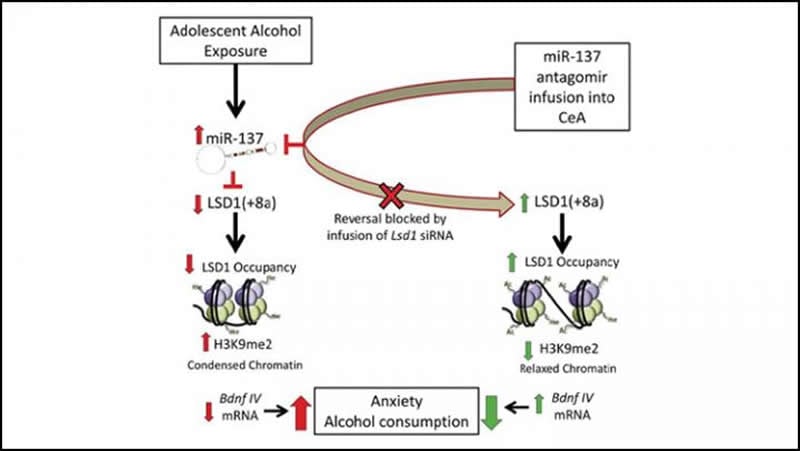Summary: Teenage binge drinking is linked to altered gene expression in the brain, specifically the central nucleus of the amygdala. Adolescent rats exposed to alcohol had increased levels of miR-137, resulting in lower expression of proteins essential for healthy neuron growth. During adulthood, these rats displayed higher levels of anxiety and an increased preference for alcohol consumption.
Source: SfN
Adolescent binge drinking modifies gene expression in a fashion that increases susceptibility to anxiety and alcohol use disorders in adulthood, according to research in rats recently published in eNeuro. Targeting the microRNAs responsible could be a new route for undoing the damage of alcohol use caused during adolescence.
Previous researchers found that microRNA, small bits of RNA that modify how genes are expressed rather than coding for a protein, are involved in how early-life alcohol exposure changes the brain, but the exact mechanism was unknown.
Kyzar et al. exposed adolescent rats to alcohol and measured the resulting levels of miR-137, one type of microRNA, in the rats’ amygdalae. The rats exposed to alcohol displayed increased levels of miR-137, resulting in lower expression of proteins necessary for healthy neuron growth and branching. In adulthood, the rats displayed higher levels of anxiety behaviors and a higher preference for alcohol compared to control rats. Inhibiting miR-137 in the amygdala reversed the anxiety and alcohol preference in the rats with an adolescent drinking history.

Source:
SfN
Media Contacts:
Calli McMurray – SfN
Image Source:
The image is credited to Kyzar et al., eNeuro 2019.
Original Research: Closed access
“MicroRNA-137 Drives Epigenetic Reprogramming in the Adult Amygdala and Behavioral Changes After Adolescent Alcohol Exposure”. Evan J. Kyzar, John Peyton Bohnsack, Huaibo Zhang and Subhash C. Pandey.
eNeuro doi:10.1523/ENEURO.0401-19.2019.
Abstract
MicroRNA-137 Drives Epigenetic Reprogramming in the Adult Amygdala and Behavioral Changes After Adolescent Alcohol Exposure
Adolescent binge drinking is a serious public health concern and a risk factor for alcohol use disorder (AUD) and comorbid anxiety in adulthood. Chromatin remodeling mediated by epigenetic enzymes including lysine-specific demethylase 1 (LSD1) due to adolescent alcohol exposure may play a role in adult psychopathology. The mechanism by which adolescent alcohol exposure mechanistically regulates epigenetic reprogramming and behavioral changes in adulthood is unknown. We investigated the role of microRNA-137 (miR-137), which is crucial for normal neurodevelopment and targets LSD1, in adolescent intermittent ethanol (AIE) exposure-induced anxiety-like and alcohol-drinking behaviors and related epigenetic reprogramming in the amygdala in adulthood. Adolescent rats were exposed to 2g/kg ethanol (2 days on/off; AIE) or intermittent n-saline (AIS) during postnatal days (PND) 28-41 and allowed to grow to adulthood for analysis of behavior, miRNA expression, and epigenetic measures in the amygdala. Interestingly, miR-137 was increased and its target genes Lsd1 and Lsd1 + 8a were decreased in the AIE adult amygdala. Infusion of miR-137 antagomir directly into the central nucleus of the amygdala (CeA) rescues AIE-induced alcohol drinking and anxiety-like behaviors via normalization of decreased Lsd1 expression, decreased LSD1 occupancy, and decreased Bdnf IV expression due to increased H3K9 dimethylation in AIE adult rats. Further, concomitant Lsd1 siRNA infusion into the CeA prevents the miR-137-mediated reversal of AIE-induced adult anxiety and chromatin remodeling at the Bdnf IV promoter. These novel results highlight miR-137 as a potential therapeutic target for anxiety and AUD susceptibility after adolescent alcohol exposure in adulthood.
Significance Statement
Adolescent alcohol exposure is a serious public health problem and contributes to alcohol use and anxiety disorders later in life. In this study, we identify microRNA-137, a small non-coding RNA, in the central nucleus of amygdala (CeA) as a crucial regulator of increased alcohol consumption and anxiety-like behavior in adult rats after adolescent intermittent ethanol (AIE) exposure. Inhibition of microRNA-137 in the CeA reverses increased alcohol intake and anxiety-like behavior, and this effect is mediated by lysine-specific demethylase 1 (LSD1), a microRNA-137 target gene that regulates epigenetic programming. Thus, we have identified microRNA-137 and its target LSD1, in the CeA that play a mechanistic role in the pathogenesis of increased adult anxiety and alcohol consumption after adolescent alcohol exposure.






